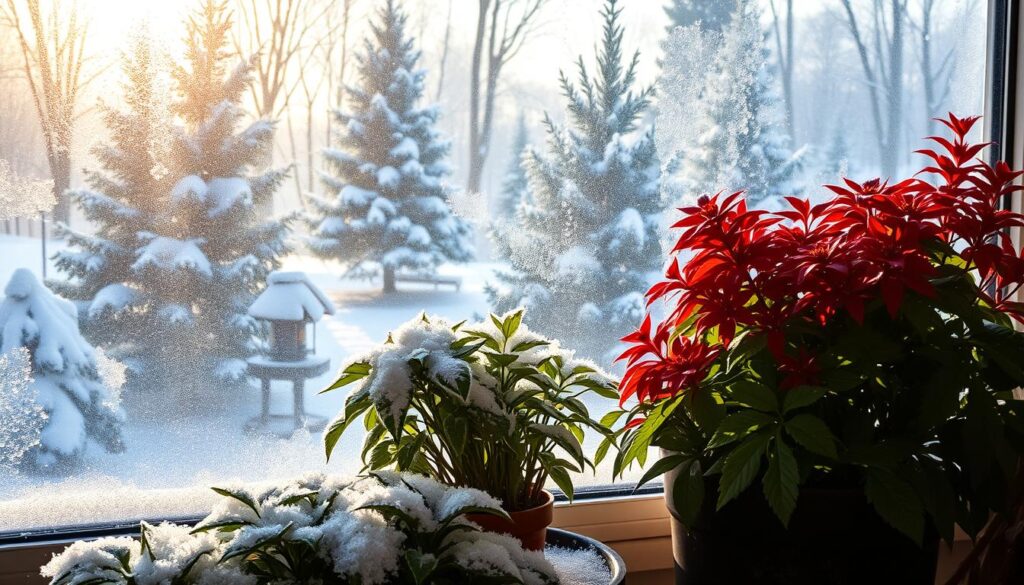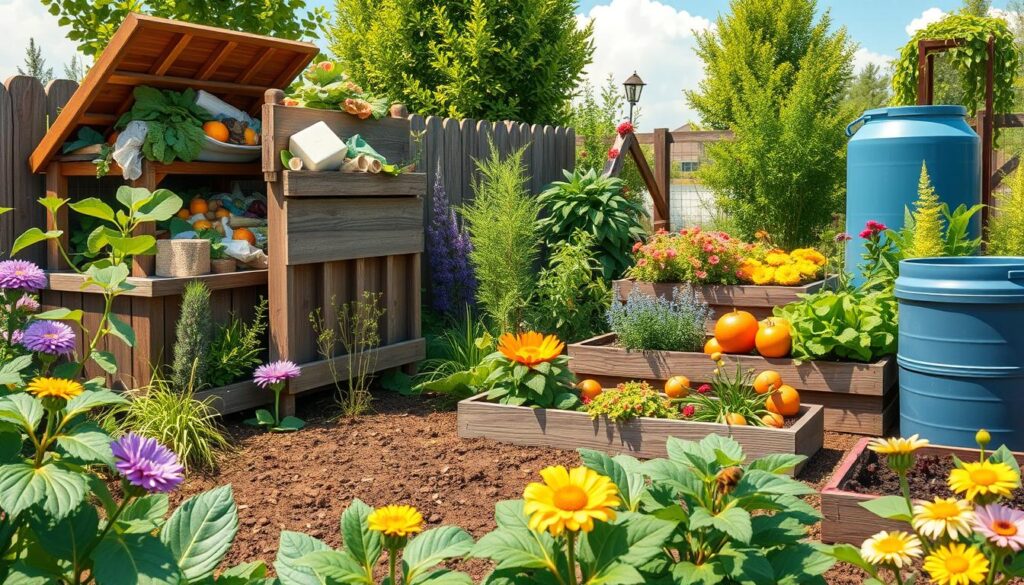Ever wondered why some gardens bloom while others struggle? The answer often lies in seasonal gardening. We’ll share essential tips for all gardeners, from beginners to experts. These tips will help you grow a lush garden all year.
Knowing when to plant and care for your garden is crucial. Let’s explore the secrets to a thriving garden in every season!
Key Takeaways
- Seasonal gardening is crucial for optimal plant growth and health.
- Timing your planting can lead to better yields and healthier plants.
- Each season presents unique challenges and opportunities for gardeners.
- Choosing the right plants based on the season is essential.
- Preparation and maintenance are key to thriving gardens.
Understanding Seasonal Gardening Basics
Seasonal gardening needs a good grasp of key principles to thrive. Timing is key for planting and harvesting to get the best results. Knowing your local climate is also crucial for making the right gardening choices.
Garden lovers should keep up with their environment to get the most out of their gardening. Tools like climate zone maps are very helpful for this.
Importance of Timing
Timing is everything in gardening. A good planting calendar helps decide when to plant and harvest. This way, gardeners can avoid bad weather that might harm their plants.
By following the calendar, gardeners can enjoy the fruits of their labor. They ensure plants grow in their best seasons. Seasonal gardening tips are essential for a successful garden.
Climate Considerations
Knowing your local weather is key to seasonal gardening. Different areas have different climates, affecting what plants grow well. For example, hot places need plants that can handle the heat, while cold areas need plants that can stand frost.
Understanding these differences helps gardeners make better choices. They can adjust their gardening plans to fit their climate. Checking a planting calendar often helps predict the best times to plant and harvest in various climates.
Preparing Your Garden for Each Season
Good garden care starts with the right preparation. This means making sure the soil is healthy for plants to thrive. Testing and improving the soil helps plants grow well. Having the right tools also makes gardening easier and more fun.
Soil Health and Amendments
Soil health is key to a successful garden. Begin by testing your soil to see its nutrient levels and pH balance. Then, use these amendments to make your soil better:
- Compost: Adds important nutrients and helps keep soil moist.
- Peat Moss: Makes soil better for plants to grow by improving its structure and air.
- Fertilizers: Give plants the nutrients they need to grow strong.
Adding these to your soil early on helps plants grow well all year.
Tools You’ll Need
Having the right tools makes gardening easier. Here’s a list of must-have gardening tools:
| Tool | Purpose |
|---|---|
| Spade | For digging and turning soil |
| Hoe | To cultivate soil and remove weeds |
| Rake | To level soil and remove debris |
| Watering Can | For easy watering of plants |
| Pruners | To trim and shape plants |
Spring Gardening Tips to Kickstart Growth
When spring comes, gardens wake up, ready for growth. It’s important to pick the right plants, use good planting methods, and water them right. This guide will help you get started with confidence.
Choosing the Right Plants
First, check your garden’s weather and soil. Here are some great plants for spring:
- Peas – They love cool weather.
- Spinach – It grows fast and is leafy.
- Marigolds – They brighten up your garden and keep pests away.
- Petunias – They’re good for many places.
Planting Techniques and Spacing
How you plant and space your plants matters a lot. Here’s what to do:
- Make holes that fit the plant’s roots.
- Put plants far enough apart for air and sun.
- Press the soil gently around the plants to keep them stable.
Watering for Success
Watering right is key in spring. Here’s how to do it:
- Water deeply but not too often to help roots grow strong.
- Check if the soil is dry a few inches down before watering.
- Think about using a soaker hose or drip irrigation to save water.
Summer Gardening Strategies for Thriving Plants
Summer gardening comes with its own set of challenges, like managing heat and keeping up with garden care. By adjusting your gardening methods, you can help your plants stay healthy and vibrant. Techniques like shading, proper watering, and pest control can make your garden shine during the hot season.
Managing Heat and Sun Exposure
It’s crucial to protect plants from the intense summer heat. Here are some strategies to consider:
- Using shade cloths: These let filtered sunlight reach your plants while shielding them from harsh rays.
- Mulching: Organic mulch keeps the soil moist and cools the roots.
- Watering wisely: Watering in the early morning helps plants absorb moisture better and reduces evaporation.
Pest Control Methods
Summer pests can quickly overrun your garden. Effective pest control includes:
- Hand-picking: Regularly check your plants and remove pests by hand.
- Natural solutions: Use neem oil or insecticidal soaps as safer options instead of chemical pesticides.
- Encouraging beneficial insects: Ladybugs and lacewings can help control pest populations.
Regular Maintenance Routines
Creating a garden maintenance schedule is key to keeping plants healthy. Here are some tasks to include:
| Task | Frequency | Purpose |
|---|---|---|
| Watering | Every 2-3 days | To maintain soil moisture |
| Weeding | Weekly | To reduce competition for nutrients |
| Fertilizing | Every 4-6 weeks | To provide essential nutrients |
| Pruning | As needed | To promote healthy growth and airflow |
Fall Gardening: Preparing for Winter
As leaves change and temperatures fall, fall gardening offers special chances for garden lovers. It’s the best time to plant cool-weather veggies and get your garden ready for winter. Using smart strategies keeps your garden healthy and productive.
Best Vegetables to Plant in Fall
For fall gardening, pick cold-hardy veggies that can handle the cold. Great choices include:
- Kale
- Brussels sprouts
- Carrots
- Spinach
- Garlic
These veggies not only survive the cold but also taste sweeter after a frost. They’re perfect for winter meals.
How to Protect Plants from Frost
Frost can harm young plants. To keep your fall garden safe, try these:
- Row covers: Lightweight fabric that traps heat and shields plants from frost.
- Mulching: Adding a layer of straw or leaves around plants to insulate the soil and retain warmth.
- Cold frames: Miniature greenhouses that provide a stable environment for tender plants.
These methods protect your veggies from unexpected cold snaps.
Clean-Up and Organizing
After the fall harvest, a thorough clean-up is key. Here’s what to do:
- Removing dead plants and debris to prevent disease.
- Composting organic matter to enrich the soil next season.
- Organizing tools and supplies for easy access in the spring.
A clean garden space helps your veggies grow better next season. It also prepares the soil for new plants.
Winter Gardening: Indoor and Outdoor Options
Winter gardening brings its own set of challenges and opportunities. Whether you garden indoors or outdoors, the right techniques and plants can keep your garden vibrant. This section will guide you on choosing winter hardy plants and the importance of garden maintenance during winter.
Choosing Winter Hardy Plants
Winter hardy plants can thrive in cold temperatures. Choosing the right ones is crucial for a successful winter garden. Here are some top picks:
- Pansies
- Winter Jasmine
- Thyme
- Ornamental Kale
- Heather
These plants add color and texture to your garden, making it more appealing in winter.
The Benefits of Indoor Gardening
Indoor gardening is a great way to keep your green thumb active during harsh weather. It offers several benefits:
- Year-round crop production
- Improved air quality
- Increased humidity in your home
- Wrapping yourself in the tranquility of nature
Choose houseplants like spider plants, peace lilies, or herbs like basil and mint. The right pots and enough light are key for healthy growth indoors.
Winter Care for Existing Plants
Proper winter care protects your outdoor plants from harsh weather. Good garden maintenance strategies help prevent damage from frost and cold winds. Here are some essential tips:
- Mulch around plants to insulate roots
- Water thoroughly before the freeze
- Use burlap or protective coverings for delicate plants
- Prune only dead or damaged branches
By following these tips, your plants will stay resilient until spring.

| Plant Type | Hardiness Zone | Care Tips |
|---|---|---|
| Pansies | 3-9 | Deadhead regularly and water before frost. |
| Winter Jasmine | 6-9 | Ensure well-drained soil and full sun exposure. |
| Thyme | 4-9 | Prune lightly and avoid overwatering. |
| Ornamental Kale | 3-9 | Provide full sun and moderate watering. |
| Heather | 5-9 | Keep soil slightly acidic and well-drained. |
Succession Planting for Year-Round Harvests
Succession planting lets gardeners enjoy fresh food all year. It means planting crops at different times so they mature when needed. This way, you get more food and waste less.
What is Succession Planting?
Succession planting is about planting different crops at the right times. Instead of growing one vegetable at a time, you plant many. This way, you can always have something to harvest.
Seasonal gardening advice suggests picking crops that grow well together. They should have different times to mature and need similar conditions.
How to Plan a Succession Schedule
Planning a succession schedule needs careful thought. You must consider the climate, the crops you want, and the season’s temperatures. Here’s a simple way to start:
- Choose Your Crops: Pick crops that grow at different times for a steady supply.
- Create a Timeline: Make a planting calendar to know when to plant for successive harvests.
- Rotate Varieties: Mix fast-growing plants like radishes with slower ones like carrots. This keeps your garden busy.
- Monitor Growth: Check your garden often and adjust your plan as needed.
By adding succession planting to your gardening routine, your garden will stay lively and productive all year. Make planning a regular part of your gardening and watch your garden thrive.
Companion Planting: Boosting Your Garden’s Health
Companion planting is a fun way to make your garden healthier. It involves choosing plants that work well together. This approach helps keep pests away and improves pollination.
By picking the right plants, you create a balanced garden. This balance supports the growth of all your plants.
Benefits of Companion Planting
This method has many perks. It keeps pests away, so you don’t need harmful chemicals. Some plants even make nutrients more available, helping your plants grow strong.
It also brings beneficial insects to your garden. These insects help with pollination, which is key for healthy plants.
Best Pairings for Each Season
Knowing the best plant pairs for each season is key. Here are some great combinations:
- Spring: Tomatoes and basil together boost flavor and keep pests away.
- Summer: Beans and corn are a great team. Beans help corn grow by fixing nitrogen in the soil.
- Fall: Garlic and roses make a good pair. Garlic helps roses fight off diseases.
- Winter: Spinach and strawberries are a good match. Spinach protects strawberries from cold.
Sustainable Gardening Practices
Sustainable gardening is good for your garden and the planet. It uses composting and water saving to make soil better. These tips will help you grow a healthy, eco-friendly garden.
Composting Basics
Composting turns kitchen waste and yard clippings into soil food. It’s great for your garden and cuts down on waste. Here’s how to start:
- Collect organic stuff like fruit peels, veggie scraps, coffee grounds, and grass clippings.
- Pick a compost bin that lets air in and drains well.
- Put green (nitrogen-rich) and brown (carbon-rich) materials together for best results.
- Stir the compost often to help it break down.
- Keep an eye on moisture to keep it just right.
Water Conservation Techniques
Water saving is key in sustainable gardening. Good methods cut down water use and keep plants healthy. Here are some tips:
- Use drip irrigation to water plants right at the roots, cutting down on evaporation.
- Put up rain barrels to catch rain for watering.
- Mulch around plants to keep moisture in and weeds out.
- Pick plants that don’t need much water.

| Practice | Description | Benefits |
|---|---|---|
| Composting | Using organic waste to create nutrient-rich soil amendments. | Reduces waste, enriches soil, promotes beneficial microbes. |
| Drip Irrigation | A system that delivers water directly to the roots of plants. | Minimizes water waste, conserves resources, enhances plant health. |
| Rainwater Harvesting | Collecting rainwater for irrigation purposes. | Reduces reliance on municipal water, lowers water costs. |
| Mulching | Covering soil with organic materials to retain moisture. | Prevents weeds, conserves moisture, improves soil structure. |
Common Seasonal Gardening Mistakes to Avoid
Gardening is rewarding but comes with challenges. Knowing common mistakes can help you improve your gardening. Avoiding these errors leads to healthier plants and a successful garden.
Misjudging Frost Dates
Misjudging frost dates is a common mistake. It’s important to know the last and first frost dates in your area. Planting too early can damage seedlings, while waiting too long can slow growth.
To do better, check local forecasts and use gardening apps. They provide up-to-date frost information.
Overwatering and Underwatering
Watering is a delicate balance. Many gardeners struggle with too much or too little water. Too much water can cause root rot, while not enough can stress plants.
Here are tips to check moisture levels:
- Use your finger to check the top inch of soil for dryness.
- Monitor the weather to adjust watering frequency based on rainfall.
- Consider each plant’s specific water needs; some require more moisture than others.
Seasonal Festivals and Gardening Events
Getting into outdoor gardening is even more fun with seasonal festivals and events. These celebrations show the joy of gardening. They also help us connect with others and appreciate nature’s gifts.
Celebrating the Harvest
Harvest festivals are all about the joy of harvesting. Local farmers’ markets are great places to see gardeners show off their crops. Here, visitors can meet the people who grew their food.
Some top harvest events include:
- Annual Apple Festival: Enjoy tastings, cider pressing, and apple pie contests.
- Pumpkin Palooza: Engage in pumpkin carving competitions and hayride adventures.
- Tomato Jubilee: Sample various heirloom tomatoes and participate in cooking demonstrations.
Local Gardening Workshops
Local gardening workshops are great for learning new things. They’re perfect for both new and seasoned gardeners. Here, you can pick up new skills, share ideas, and learn about the latest in gardening.
Some common topics include:
- Organic gardening practices and pest management.
- Plant propagation techniques and seasonal planting schedules.
- Composting and sustainable gardening methods.
Resources for Continued Gardening Education
If you love gardening, there are many ways to get better at it. You can find lots of books and websites that give great advice. “The Garden Primer” by Barbara Damrosch and “Botany for Gardeners” by Brian Capon are great for beginners and experts alike.
Recommended Books and Websites
There are also many websites that are full of gardening tips. The Royal Horticultural Society and the American Horticultural Society have lots of useful articles. By visiting these sites often, you can stay up-to-date with the latest gardening trends.
Joining Local Gardening Clubs
Joining a local gardening club is another great idea. Clubs offer a chance to meet other gardeners, share tips, and learn new things. You’ll get to attend workshops and events, which can make your gardening even more fun and rewarding.
FAQ
What is seasonal gardening?
Seasonal gardening means planting and caring for your garden based on the seasons. It’s about knowing when to plant and harvest different plants. This ensures your garden grows well all year.
How do I know when to plant my vegetables?
Use a planting calendar for your area to find out when to plant veggies. Knowing your local frost dates and weather is key for growing veggies.
What tools do I need for garden maintenance?
You’ll need spades, hoes, rakes, watering cans, pruners, and gloves. These tools make tasks like planting and weeding easier and faster.
How can I protect my garden from pests during the summer?
Use organic pest control like neem oil or insecticidal soaps. Check your plants often, introduce beneficial insects, and rotate crops to keep pests away.
What should I do to prepare my garden in the fall?
Clean up old plants, plant hardy veggies like kale, and mulch to protect the soil. This prep work helps your garden thrive in the spring.
Are there benefits to indoor gardening during the winter?
Yes! Indoor gardening lets you grow plants when it’s cold outside. It’s a great way to enjoy fresh herbs and veggies, and keep your gardening skills sharp.
What is succession planting, and how does it help my garden?
Succession planting means planting crops in stages for a steady harvest. It boosts yield, reduces waste, and uses garden space well.
What are some common mistakes to avoid in seasonal gardening?
Avoid planting too early and getting plants wet or dry. Watch the weather and know your plants’ water needs to avoid these mistakes.
How can I celebrate seasonal gardening events in my community?
Join local farmers’ markets, harvest festivals, and gardening workshops. These events are great for meeting other gardeners, learning new things, and celebrating your gardening success.
What resources are available for ongoing gardening education?
There are many resources like gardening books, websites, and clubs. They offer valuable info and chances to connect with other gardeners.


